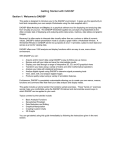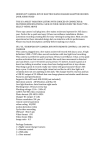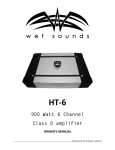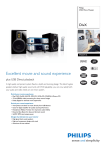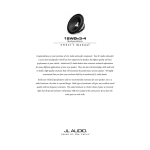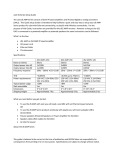Download mp-subf2.1 manual(说明书)
Transcript
MP-SUBF2.1 8-Inch 2.1CH Super Flat Active Subwoofer User's Manual Front panel controls and features 10 1 2 3 4 5 6 1 REMOTE LEVEL CONTROL PORT 7 8 9 7 LOW PASS FILTER Attach the included remote level control to control the volume level of the subwoofer independently. The LOW PASS rotary potentiometer permits the setting of the low-pass filter value. The selected value defines the frequency until which the signal is amplified. 2 INPUT GAIN CONTROL 4 After you have installed your system, turn this control to minimum. 8 PHASE SHIFT Turn the head unit on (and the subwoofer will turn on via the remote connection). Turn the head unit volume to about 2/3 full level. Use this switch to help compensate for time alignment problems in the system. Such problems usually result from having the subwoofer at a different distance from the listener than the other speakers in the system. Slowly turn up the subwoofer input gain control until you hear a small amount of distortion. Then reduce the level until the distortion is completely gone. Level the control at this setting. 9 3 Hi PASS : The HI-PASS rotary potentiometer permits to adjust the high-pass filter value (the amplification is ensured up to the selected value). POWER STATUS LED The light indicator permits to check the correct working of the amplifier. When the LED is green, it means the amplifier is on and it’s working correctly.When the LED is red,it means the amplifier is in protection mode following a dysfunction (overheating,wrong wiring). 10 AUTO POWER ON 5 SUBSONIC FILTER The AUTO POWER ON (ON / OFF) is for high level (speaker-level) connections. When the switch is in the "ON" position, the subwoofer AUTO POWER ON when there is signal input. If the amplifier detected no signal input, the amplifier will auto turn off delay Several minutes. If you prefer to use the remote turn on/off connection, the switch is in the OFF position. Use this control to filter out low frequency noise and rumble. 6 BASS BOOST The bass boost rotary potentiometer permits to increase the bass level from 0 to +18dB. 2 Rear panel controls and features 1 2 1 POWER TERMINALS 3 4 4 LOW LEVEL RCA INPUTS Low level inputs are the recommended way to introduce the audio signal to the subwoofer if RCA outputs are present on your head unit or other signal source (such as a sound processor). 2 FUSE The fuse is rated at 30A. Do not use a fuse with a different value and NEVER replace the fuse with a wire or coin. 3 OUTPUT/HI LEVEL INPUT The output / high level terminal permits to connect the source with high-level signal but also to lead the bass enclosure amplified signal towards the speakers ( left part :OUTPUT ) In the case of a RCA connection, you must disconnect the plug on the cable beam.These outputs permit to amplify your front channels (a 2-way kit) with a very high power (2x50W RMS).CAUTION:you must respect this order,if not you might damage the product. 3 Low Level Input Wiring Low-level (RCA) input wiring is preferred for best audio performance. Most trunk or hatchback installations will require a 15-20 feet RCA cable, while pickup trucks and under-seat installations will require a 6-12 feet RCA cable. Always use a high quality cable. NOTE: Do not connect BOTH the high level and low level inputs from your receiver to your amplifier at the same time! Green L+ Green/ BLACK L- R+ Purple R- Purple / BLACK To Audio outputs of head unit or signal processor OUTPUT / High Level Input Wiring The high level input(s) should only be used when your receiver lacks RCA outputs. If the RCA outputs are not present, connect the speaker outputs from the receiver to the high level input connector of the amplifier. Be sure to observe polarity to avoid audio phase problems. NOTE: Do not connect BOTH the high level and low level inputs from your receiver to your amplifier at the same time! BLACK WIRING METHOD A Green L+ Green / BLACK LPurple R+ Purple / BLACK R- L+ WHITE L- WHITE / BLACK R+ GREY R- GREY / BLACK To Speaker Terminals of head unit 4 WIRING METHOD B BLACK L+ WHITE / BLACK Green / BLACK L+ NOTE: The head unit includes different speaker output type. At First,Please use wiring method A If No Sound comes out, please use wiring method B. Purple / BLACK R+ Purple R- Chassis ground point R+ GREY / BLACK R- GREY To Speaker Terminals of head unit Power Connections FUSE L- WHITE Green L- Battery to REMOTE TURN-ON terminal of head unit NOTE: In this connection, the AUTO TURN ON switch is in the OFF position. Power Connections FUSE If you use high level inputs,AUTO TURN ON switch in the “ON” position, the subwoofer auto turn on when there is signal input,this connection is input signal control subwoofer TURN-ON or TURN-OFF.If subwoofer detected no speaker-level input,the subwoofer will TURN -OFF delay several minutes . if you prefer remote turn on / turn off connec-tion,the switch is in the OFF position. Battery Chassis ground point 5 Remote Level Control Connection Remote Level Control Install the remote control securely under the dash or in a similar location where using it will not distract the driver. Specifications MODEL: MP-SUBF2.1 RMS power SUB STEREO 80W@2Ohm 2x50W@4Ohm THD <0.4% <0.1% Signal-to-noise ratio >90dB >100dB Frequency response 20Hz - 150Hz 50Hz - 20KHz 1.0V Input sensitivity, high level 0.8V Input sensitivity, low level 180mV 200mV Low Pass Filter 50Hz - 150Hz / Bass Boost 0 to + 18dB / Subsonic Filter 20Hz - 50Hz 50Hz - 150Hz(HPF) 2 Ohm 4-8 Ohm Load Fuse rating 30A Subwoofer 8inch Dimensions(L x W x H) mm 344 x 250 x 68 All specifications subject to change without notice. 6 Troubleshooting If you experience operation or performance problems with this product, compare your installation with the electrical wiring diagram on the previous pages. If problems persist, read the following troubleshooting tips which may help eliminate the problems. SYMPTOM POSSIBLE REMEDY Amplifier will not power up. Check to make sure you have a good ground connection. Check that the Remote Input (Turn-On) has at least 3VDC. Check that there is battery power on the (+) terminal. Check that there is at least 12v. Check all fuse, replace if necessary. Make sure that the Protection LED is not illuminated. If it is lit, shut off the amplifier briefly, and then repower it. Protection LED comes on when amplifier is powered up Check for short circuits on speaker leads. Turn down the volume control on the head unit to prevent overdriving. Remote speaker leads, and reset the amplifier. If the Protection LED still comes on, then the amplifier is faulty and needs servicing. No output. Check that all fuses are OK. Check that unit is properly grounded. Check that the Remote Input (Turn-On) has at least 3VDC. Check that the RCA audio cables are plugged into the proper inputs. Check all speaker wiring. Low output. Reset the Level Control. Check the Crossover Control settings. High hiss in the sound. Disconnect all RCA inputs to the power sub's control panel. If the hiss disappears, then plug in the component driving the amplifier and unplug its inputs. If the hiss disappears at this point, go on until the faulty/noisy component is found. It is best to set the amplifier's input level control as low as possible. The best subjective signal-to-noise ratio is achieved in this manner. Try to set the head unit as high as possible (without distortion) and the amp input level as low as possible. Squealing noise is present. Check for improperly grounded RCA interconnects. Distorted sound. Check that the Input Level Control is set to match the signal level of the head unit. Always try to set the Input Level as low possible. Check that all crossover frequencies are properly set. Check for short circuits on the speaker leads. Amplifier gets very hot. Check that the minimum speaker impedance for the amp model is correct. Check that there is good air circulation around the amp. In some applications, it may be necessary to add and external cooling fan. Engine noise (static type) This is usually caused by poor quality RCA cables, which can pick up radiated noise. Use only the best quality cables, and route them away from power cables. Engine noise (alternator whine) Check that the RCA grounds are not shorted to the vehicle chassis Check that the head unit is properly grounded. 7








